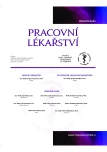Why is indicated application of hyperbaroxia in inflammatory bowel disease?
Authors:
M. Emmerová 1; Z. Poklopová 1; D. Suchý 1; J. Růžička 1; P. Mikoláš 2
Authors‘ workplace:
Oddělení klinické farmakologie FN Plzeň, přednosta prim. MUDr. David Suchý, Ph. D.
1; Ambulantní specializovaný gastroenterolog MUDr. Petr Mikoláš, Plzeň
2
Published in:
Pracov. Lék., 71, 2019, No. 3-4, s. 83-87.
Category:
Review Article
Overview
The authors deal with the problems of autoimmune intestinal inflammations (ulcerous colitis, Crohn’s disease), which are treated from the half of previous century with increasing numbers of therapeutic drugs and occurrence of untoward effects. It is a sort of made-up therapy, in other words, no listed drug is completely excluded from this pathogenetic therapy. Quite the contrary – the number of drugs is increasing.
Many western foreign institutions use hyperbaric oxygen therapy, which corrects hypoxia of the affected intestinal segment, decreases the occurrence of anaerobic flora, exerts immunosuppressive effects as well and disposes of gas bubbles, which contribute to destruction of the affected intestine. In case of originating toxic megacolon, especially in ulcerous colitis, it is almost absolute indication to use hyperbaric condition in the presence of gas in the intestine. In the Crohn’s disease, hyperbaric oxygen therapy is urgently indicated especially ion cases, where fistulas have already developed. The use of hyperbaric oxygen therapy substantially limits the extent and doses of medicament therapy and therefore logically limits or totally excludes the occurrence of undesirable effects. Last, but not least, a combination of hyperbaric oxygen therapy and lower doses of corticoids are economically advantageous in comparison of costly biological therapy. It is preferred in certain circles in the world, although its undesirable effects are admitted as well as not quite reliable effects.
The use of HBO brings about surprising results: healing is accelerated, fistulas are cured, and the duration of remissions with decreased frequency of relapses of these diseases. The author of Pilsen (Plzeň) returned to the 80s of the previous century, when the use of hyperbaric oxygen therapy was officially presented at the Czechoslovak Gastroenterology Congress in Karlovy Vary (Carlsbad). The authors recommend introduction of a coordinated teamwork in the Czech and Slovak Republics cooperatively.
Keywords:
autoimmune diseases – Crohn’s disease – ulcerous colitis – biological therapy – immunosuppression – hyperbaroxia – hyperbaric oxygen therapy
Sources
1. Klener, P. Vnitřní lékařství. 2. přepracované vydání. Praha:Karolinum, 2001, s. 481–486. ISBN 80-246-0273-3.
2. Konečný, M. Biologická léčba idiopatických střevních zánětů, dostupné ad 11.
3. Lezzi, L. E., Feitosa, M. R., Medeiros, B. A., Aquino, J. C., Almeida, A. L., Parra, R. S., Rocha, J. J., Féres, O. Crohn´s disea-se and hyperbaric oxygen therapy. Acta Cir Bras., 2011, 26, Suppl 2, s. 129–132.
4. Chott, L., Emmerová, M., Steinigerová, J., Kratochvíl, J., Dyrhonová, V., Brůhová, H., Těšínský, P., Berková, E. Léčba hyperbaroxií u chronické proctokolitidy. Čs. gastroenter. a výž., 1988, 42, 5–6, s. 336.
5. Frühauf, P. Střevní mikrobiota, její význam a možnosti ovlivnění. Dostupné na www: https://www.prolekare.cz/novinky/strevni-mikrobiota-jeji-vyznam-a-moznosti-ovlivneni-7904.
6. Feitosa, M. R., Féres Filho, O., Tamaki, C. M., Perazzoli, C., Bernardes, M. V., Parra, R. S., Rocha, J. J., Féres, O. Adjunctive Hyperbaric oxygen therapy promotes successful healing in patients with refraktory Crohn´s disease. Acta Cir Bras, 2016, 31, Suppl 1, s. 19–23.
7. Hájek, M. Hyperbarická medicína. Praha:Mladá fronta, 2017. Aeskulap. ISBN 978-80-204-4235-2.
8. Agrawal, G., Borody, T., Turner, R., Leis, S., Campbell, J. Combining infliximab, anti-MAP and hyperbaric oxygen therapy for resistant fistulizing Crohn´s disease. Future Sci OA, 2015, 1, 4, s. FSO77.
9. Aguilera-Castro, L., Ferre-Aracil, C., Garcia-Garcia-de-Parades, A., Rodriguez-de-Santiago, E., Lopez-Sanroman, A. Management of complex perianal Crohn´s disease. Ann Gastroenterol., 2016, 30, 1, s. 33–44.
10. Dulai, P. S., Gleeson, M. W., Taylor, D., Holubar, S. D., Buckey, J. C., Siegel, C. A. Systematic review: The safety and efficacy of hyperbaric oxygen therapy for inflammatory bowel disease. Aliment Pharmacol Ther., 2014, 39, s. 1266–1275.
11. https://www.prolekare.cz/kreditované-kurzy/biologicka-lecba-idiopatickych-strevnich zanetu-88.
12. Lukáš, M. Moderní léčba ulcerózní kolitidy. Lékařské listy gastroenterologie, 2014, 6, s. 13–16.
13. Pagoldh, M., Hultgren, E., Arnell, P., Eriksson, A. Hyperbaric oxygen therapy does not improve the effects of standardized treatment in a severe attack of ulcerative colitis: a prospective randomized study. Scandinavian Journal of Gastroenterology, 2013, 48, 9, s. 1033–1040.
14. Barcal, R., Emmerová, M., Hadravský, M. Hyperbarie a hyperbarická oxygenoterapie. Plzeň, Škoda JS a.s. a Vydavatelství J. Kuna, 2000. 122 s.
Labels
Hygiene and epidemiology Hyperbaric medicine Occupational medicineArticle was published in
Occupational Medicine

2019 Issue 3-4
Most read in this issue
- Hydrogen sulfide poisoning as an occupational disease
- Diagnosis of epicondylitis humeri using quantitative three-phase bone scintigraphy
- Nodes on vocal folds in employees of a call center
- Why is indicated application of hyperbaroxia in inflammatory bowel disease?
